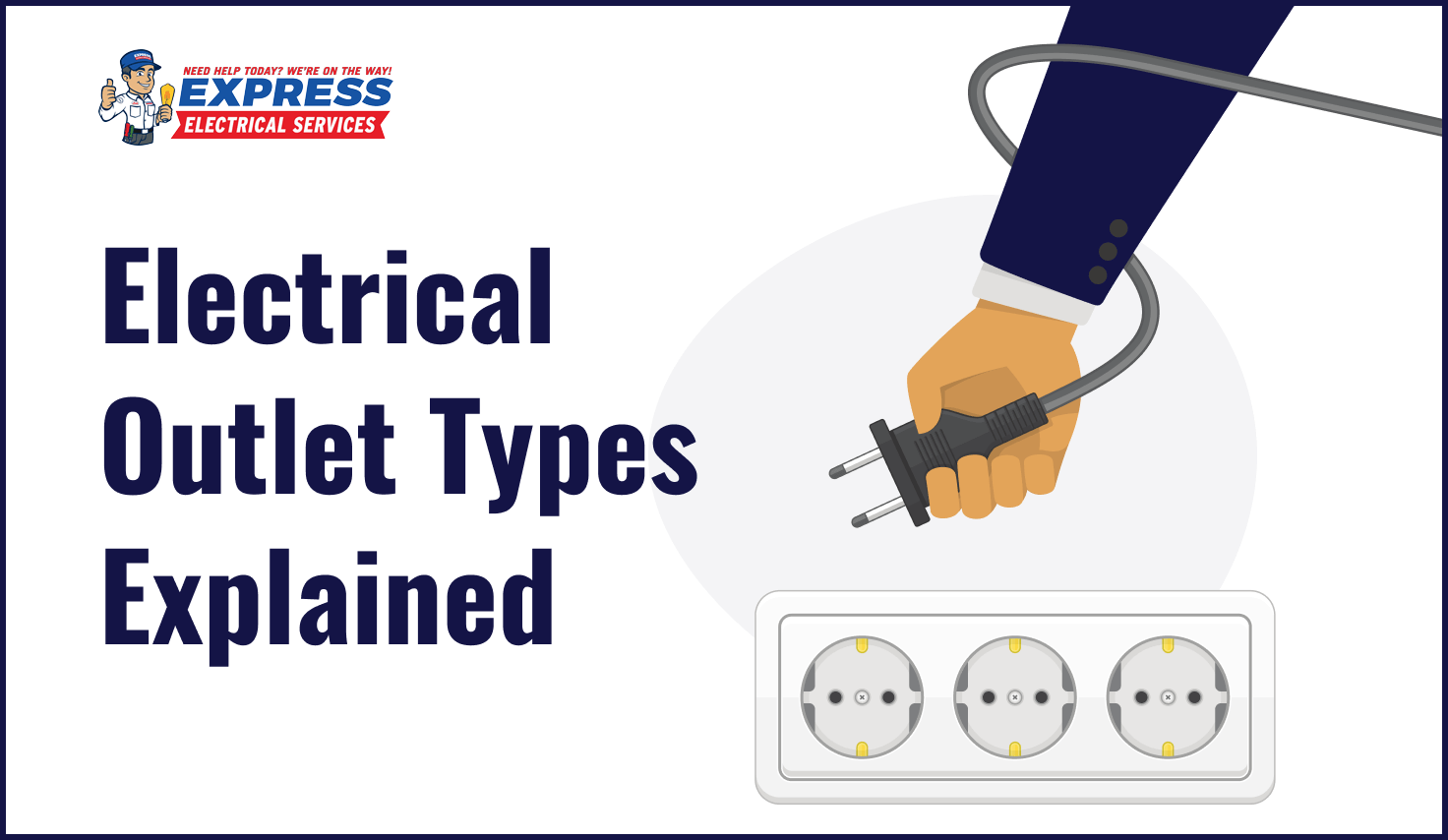Electrical Outlet Types Explained

There are different types of electrical outlets throughout your home. Although they all have the same basic purpose, some are better for certain rooms, protecting against electrical hazards, or improving energy efficiency. Each outlet provides access to an electrical circuit connected to the electrical panel; it’s part of a loop that allows electricity into devices, fixtures, and appliances. These are the different electrical outlet types you may see as you go from room to room.
Domestic electrical outlets in North America are designed to supply 120 volts. In Europe, they supply 220-240 volts. The size and shape of outlets vary from one country to another, but the basic design and types are the same.
Two-Pronged vs. Three-Pronged Outlets
a two-pronged outlet is polarized so plugs can only be inserted one way. The larger slot is the neutral line and the smaller is the hot line. Polarized plugs can only be inserted in one orientation, which is a safety feature that minimizes the risk of shock. Two-pronged outlets are more common in older homes and don’t have a grounding wire, which is a requirement in newer buildings and neutralizes dangerous currents.
A three-pronged outlet has a grounding slot. The grounding wire is connected to the outlet and breaker box. This protects appliances and computers from surge damage and allows for a more stable voltage to reduce wear. Without grounding, a hot wire contacting the metallic casing of a device would create a shock hazard. The grounding wire connects directly to the casing to divert current to the ground, trip the circuit breaker, and cut any electrical flow to the device.
GFCI Outlet
A GFCI outlet is otherwise known as a Ground Fault Circuit Interrupter. It’s most commonly used where the outlet or device plugged in could be exposed to water, like in the bathroom or kitchen, near the water heater or furnace, or outside your home. The outlet constantly monitors the current going through it. If the current returning to the outlet changes, the GFCI will disconnect the circuit automatically. The “reset” button restores power after the outlet trips, while the “test” button helps make sure the outlet is working.
AFCI Outlets
An Arc Fault Circuit Interrupter, or AFCI, detects electrical arcing between loose contact points. Arcing can be detected through sparks and buzzing and can overheat wires and appliances. Like a GFCI, it breaks the circuit when a problem is detected. AFCI outlets are recommended for safety in bedrooms, kitchens, and laundry rooms.
Common Power Ratings
There are electrical outlet types that come in different power ratings depending on the application. These include:
- 15A, 120 Volt Outlets: The simplest and most affordable outlets, these are best for low-power appliances and devices. They’re more common in older homes.
- 20A, 125 Volt Outlets: Handle a larger power draw to support larger appliances, such as dishwashers, washing machines, and space heaters. A small horizontal slot next to the vertical ground slot sets these apart.
- 20A, 250 Volt Outlets: Support the highest power appliances like air conditioners, shop equipment, and air compressors. They require a dedicated circuit with a double-pole circuit breaker in the main panel. For even higher power appliances, consider a 30A or 50A outlet.
Tamper-Resistant Outlets
Mandatory in most places, tamper-resistant receptacles have internal barriers that prevent foreign objects from being inserted. These shutters only open when the proper plug is inserted. This is an important safety feature if you have children; if they try to put something other than a plug in the outlet, the shutters eliminate the risk of shock.
Switched Outlets
Integrate a socket and switch that controls power to any appliance or light that’s connected to the outlet. There’s no need to remove the plug. Even better, a new electrical box or extra wiring is not required for installation.
USB Outlets
USB ports are built into these outlets to charge USB-powered devices, such as smartphones and tablets. These outlets can have one or more USB sockets and are often integrated with the same plate as three-pronged outlets.
Smart Outlets
In addition to allowing devices to be plugged in, smart outlets monitor power usage and can help improve energy efficiency. They can be programmed so you can set, for example, lights, coffee makers, or lawn sprinklers on a schedule. Depending on the outlet, it may be compatible with Zigbee, Wi-Fi, or other wireless protocols. Smart outlets can be operated through Amazon Echo, Google Home, or via your smartphone.
Need Help with Electrical Outlets? Contact Express Electrical Services
We provide a wide range of electrical services throughout Los Angeles and Southern California. If you need an outlet repaired, installed, or upgraded, our certified electricians are equipped to help with all electrical outlet types. Express Electrical Services is available 24/7 and offers specials and financing to accommodate your budget should you need more extensive electrical work. Call 323-727-7799 or contact us online to schedule service.

Leave A Comment